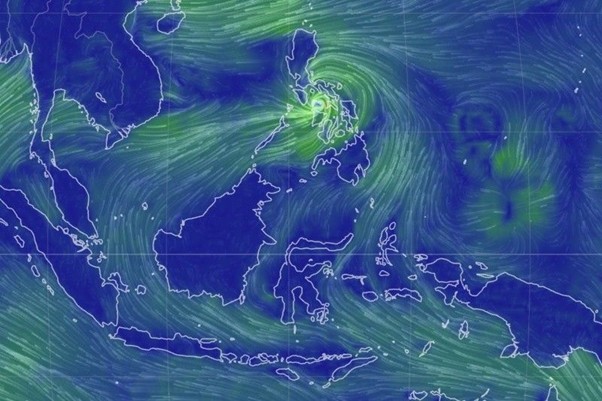Tropical Storm Opong Approaches Philippines
The Philippines is facing widespread disruption after Tropical Storm Opong (international name Bualoi) made landfall over Masbate in the early hours of Friday, 26 September 2025. According to the latest PAGASA bulletin, Opong has weakened slightly into a severe tropical storm but continues to pose significant risks to Southern Luzon, Eastern Visayas, and Metro Manila.
At 0400 hours on Friday, the storm’s centre was located near Palanas, Masbate, packing maximum sustained winds of 110 km/h, gusts of up to 150 km/h, and a central pressure of 985 hPa. Moving west-northwest at 30 km/h, storm-force winds extended 460 km from its centre, creating widespread hazards across multiple provinces.
Areas Under Tropical Cyclone Wind Signal
- TCWS No. 3: Sorsogon, Masbate, Albay, Romblon, Oriental Mindoro, Batangas, and southern Laguna in Luzon; Northern Samar, Samar, Biliran, and northern Leyte in Visayas.
- Expected Impact: Storm-force winds (89–117 km/h) with moderate to significant risks to life and property.
In addition, heavy rainfall of over 200 mm was forecast for multiple provinces, including Samar, Northern Samar, Biliran, Masbate, Albay, Batangas, and Mindoro, leading to risks of severe flooding, landslides, and storm surges.
Evacuations and Emergency Measures
Authorities launched large-scale evacuation operations across the storm-hit regions:
- Over 433,000 residents have been preemptively evacuated from Bicol, Eastern Visayas, and Mimaropa.
- The Philippine National Police deployed forces to assist with evacuation and relief efforts.
- Iloilo City suspended work in government offices, while private companies were encouraged to reduce or halt operations.
- The MMDA suspended the Expanded Number Coding Scheme (UVVRP) across Metro Manila to ease travel amid heavy rain and flooding.
The National Grid Corporation of the Philippines (NGCP) reported that transmission lines in Samar provinces and Negros Oriental were affected, causing localized power outages.
Casualties and Damage
The Office of Civil Defense confirmed four fatalities in the Bicol Region and at least six people missing in Eastern Visayas. Heavy flooding has already been reported in areas such as Barangay San Pablo, Naval, where streets were inundated, disrupting local movement and relief efforts.
Strong winds have downed trees, damaged homes, and blocked major roads, complicating access for emergency responders.
Impact on Metro Manila and Beyond
Though the storm’s core impact is focused on Bicol and Visayas, Metro Manila remains under threat of localized flooding and storm surges. Residents in low-lying areas, particularly in Bulacan, Pampanga, and Bataan, were warned of 1–3 meter storm surges within the next 24 hours.
Key disruptions include:
- Transport: Flight delays and cancellations across Luzon; ferry services suspended; inter-island shipping restricted.
- Power and Communication: Risk of prolonged power outages in heavily affected regions.
- Supply Chains: Delays in cargo and logistics movement due to road closures, blocked highways, and port suspensions.
- Public Safety: Schools closed, events postponed, and advisories urging people to avoid unnecessary travel.
Outlook
PAGASA forecasts that Tropical Storm Opong will exit the Philippine Area of Responsibility (PAR) by Saturday afternoon, 27 September, after crossing Oriental Mindoro and entering the Mindoro Strait. Once it moves over the West Philippine Sea, the storm is expected to re-intensify into a typhoon, raising concerns for international maritime routes.
In the short term, flooding, landslides, and storm surges will remain the primary risks, particularly in Southern Luzon and Visayas. Metro Manila and nearby provinces may continue to experience heavy rainfall and transport disruptions through Saturday.
Recommendations
- Residents: Avoid coastal areas and flood-prone zones. Stay indoors, prepare for possible power outages, and monitor advisories from PAGASA (https://www.pagasa.dost.gov.ph).
- Businesses: Activate continuity plans, delay non-essential deliveries, and ensure employee safety.
- Travellers: Confirm flight status before heading to airports. Account for flood-related road delays and use alternate transport where necessary.
- Local Communities: Cooperate with evacuation orders, prepare emergency kits, and prioritize vulnerable groups including children and the elderly.
Conclusion
The Tropical Storm Opong crisis underscores the Philippines’ vulnerability to extreme weather events. With mass evacuations, casualties, and infrastructure damage already reported, the storm’s impact will likely extend beyond immediate flooding and into recovery operations. For Metro Manila and surrounding provinces, vigilance, preparation, and coordination remain the best safeguards against the storm’s continuing risks.
Stay Ahead of Threats with datasurfr Predict
MitKat’s datasurfr delivers accurate, real-time, and contextualised data to help organisations respond swiftly to physical, environmental, and cyber threats.
With datasurfr Predict, our AI Agent not only provides context for unfolding events but also analyses vetted historical data to forecast how events are likely to evolve and their potential impact using industry and location-specific probabilistic scores. Book a free demo today and see how datasurfr Predict can transform your risk preparedness.


